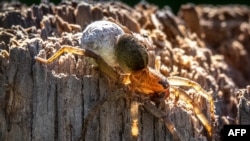A new study suggests earlier Arctic springs driven by climate change are providing wolf spiders in the region the opportunity to have more babies.
The study, published in the June 24 edition of the biological sciences journal Proceedings of the Royal Society B, found that Arctic wolf spiders are taking advantage of the early spring season by producing more batches of offspring — called clutches — because warmer temperatures extend the season when the spiders are active.
Authors of the study, from the Arctic Research Center at Denmark’s Aarhus University, dissected individual egg sacs from the spiders and counted the number of eggs and partially developed juvenile spiders. They compared those egg contents with the size of the mothers and determined that the spiders were producing two separate clutches, something previously only observed in spiders living in lower latitudes.
The spiders hatched during the second clutch appeared significantly later in the season. In years when the snowmelt happened earlier, the first clutches occurred earlier, and the second clutches were larger, the study shows.
The study provides the first evidence of invertebrates in the Arctic producing additional clutches as a result of global warming. The researchers say this could be a “common but overlooked phenomenon due to the challenges associated with long-term collection of life-history data in the Arctic."
Researchers say that this effect could also have implications for Arctic ecosystems as a whole because wolf spiders are widely distributed.









